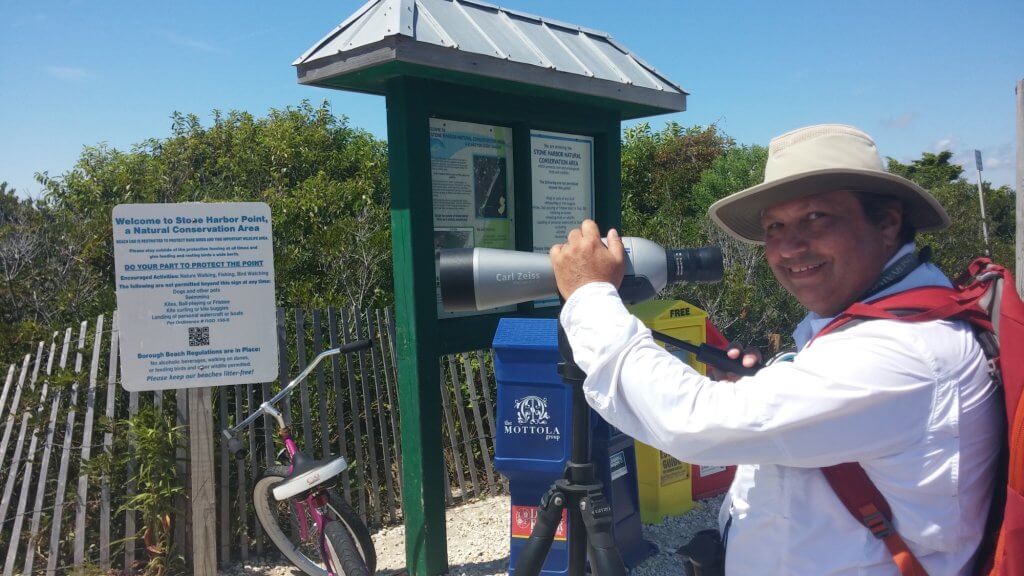STONE HARBOR – “Not all beaches are the same” according to the vice president of research for the New Jersey Audubon Society as he toured nesting areas for migratory shorebirds at Stone Harbor Point.
“We have a responsibility to take care of what enriches us,” David Mizrahi, Ph.D., explained as he looked over Hereford Inlet at the southernmost tip of Seven Mile Island. “We owe it to future generations to show our children that nature and people can exist together.
“We’d all lose something if we didn’t have areas like this,” he added.
As part of the Audubon Society, Mizrahi is working to improve the habit for shorebirds with an $1.3-million grant funded by the Hurricane Sandy Restoration Fund.
The Hurricane Sandy Coastal Resiliency Competitive Grant Program supports projects that reduce communities’ vulnerability to the growing risks from coastal storms, sea level rise, flooding, erosion and associated threats through strengthening natural ecosystems that also benefit fish and wildlife.
The program, funded by the Hurricane Sandy disaster relief appropriation through the Department of the Interior (DOI), is administered by the National Fish and Wildlife Foundation (NFWF.)
According to Mizrahi, Stone Harbor Point is a highly dynamic coastal site that experiences changes in length, width, and height on an annual basis and is one of a few unimproved inlets along the New Jersey and mid-Atlantic coastline.
Early successional beaches provide critical habitat for many species of birds to nest, roost, and forage, including Red Knots, Piping Plovers, and the American Oystercatcher.
The northern portion of the site is more stable and has persisted in a similar configuration for more than a decade, while the southern parts near Hereford Inlet, which separates North Wildwood and Stone Harbor, vary more widely.
“Beach restoration has several benefits including an increase in coastal resiliency, improved suitable habitat for beach nesting and roosting shorebirds, and increased community engagement,” he noted.
Beach and biological monitoring results will aid an innovative plan for continued beach restoration maintenance.
“The habitat loss has increased with the recent frequency and magnitude of storms hitting the coastal beaches,” Mizrahi explained, referring to the “unnamed storm” that damaged much of the Cape May County shoreline October 2015 and Winter Storm Jonas, which damaged the coastline in January 2016.
“Many of the birds don’t live here year-round, but we are an important stop along their migratory path,” he said.
The leading ornithologist explained some of the birds – the Piping Plover, the American Oystercatcher, the Black Skimmer and Terns – are on a federal or state endangered list and have returned to the area after being absent for a few years.
Mizrahi said monitoring the birds helps conservationists better understand why birds select a particular area for breeding some years and not others. For instance, four nesting plover chicks were born this year after a couple of years with none. Red Knots were seen in the Seven Mile Island habitat, after years of absence. About two dozen American Oystercatcher pairs also returned this year and last.
However, not all is good news, he said. One hundred fifty pairs of Nesting Terns and Black Skimmers had hatchlings this year, but a group of foxes with young came through the area a couple of weeks ago and apparently killed most of them in what Mizrahi called “a training” for the young.
“Part of what we do is monitor the birds,” Mizrahi said, referring to work to locate nests, count eggs, monitor the hatching schedule, and monitoring lost nest causes, which can range from fox, skunks, coyote and cats destroying nests and eggs to wash-outs from storms and high tides. “Next year, special precautions will be taken to protect nests and fledglings from future fox training episodes.”
Mizrahi also spends time in South America where many of the birds migrate so he can help understand the full migratory cycle and factors along the way that could impact a species. “It’s helpful to understand the fully functional ecosystem,” he noted. “If something happens along the way, we need to understand its impact and what can be done about it.”
The grant The Audubon Society received will be used as a long-term community resiliency strategy to be replicated in similar communities. Mizrahi noted that one of the “unique” aspects of the work in Stone Harbor was the “backpassing” (vs. dredging) beach restoration method used to transfer sand deposited from Hurricane Sandy from some points of the island to other areas that are less stable.
Three areas were elevated for the birds by about 50,000 cubic yards of recycled sand, providing safe areas for nesting colonies of Skimmers and Terns interspersed with the solitary nesters, Piping Plover and Oystercatchers, which occasionally nest on the same beaches. The dunes help protect the nesting areas and damage from storms.
While Stone Harbor manages the conservation area, which is at the end of Second Avenue near 122nd Street, the work requires partnerships with the Audubon Society, Army Corps of Engineers, Wetlands Institute, Wildlife Conservation Society, L.J. Niles Associates LLC and the State of New Jersey.
“While there is some sacrifice because this area is restricted,” Mizrahi said overlooking the conservation area where swimming, boating and surfing are not allowed, “We would lose more than we have if we didn’t have areas like this. I’d prefer we spend the money on this rather than something else.”
To contact Karen Knight, email kknight@cmcherald.com.
Cape May Beach – So Democrat governors and mayors think their authority is greater than federal authority? That’s hilarious! I see some of them say you’re not coming for my people meaning people here illegally while…







